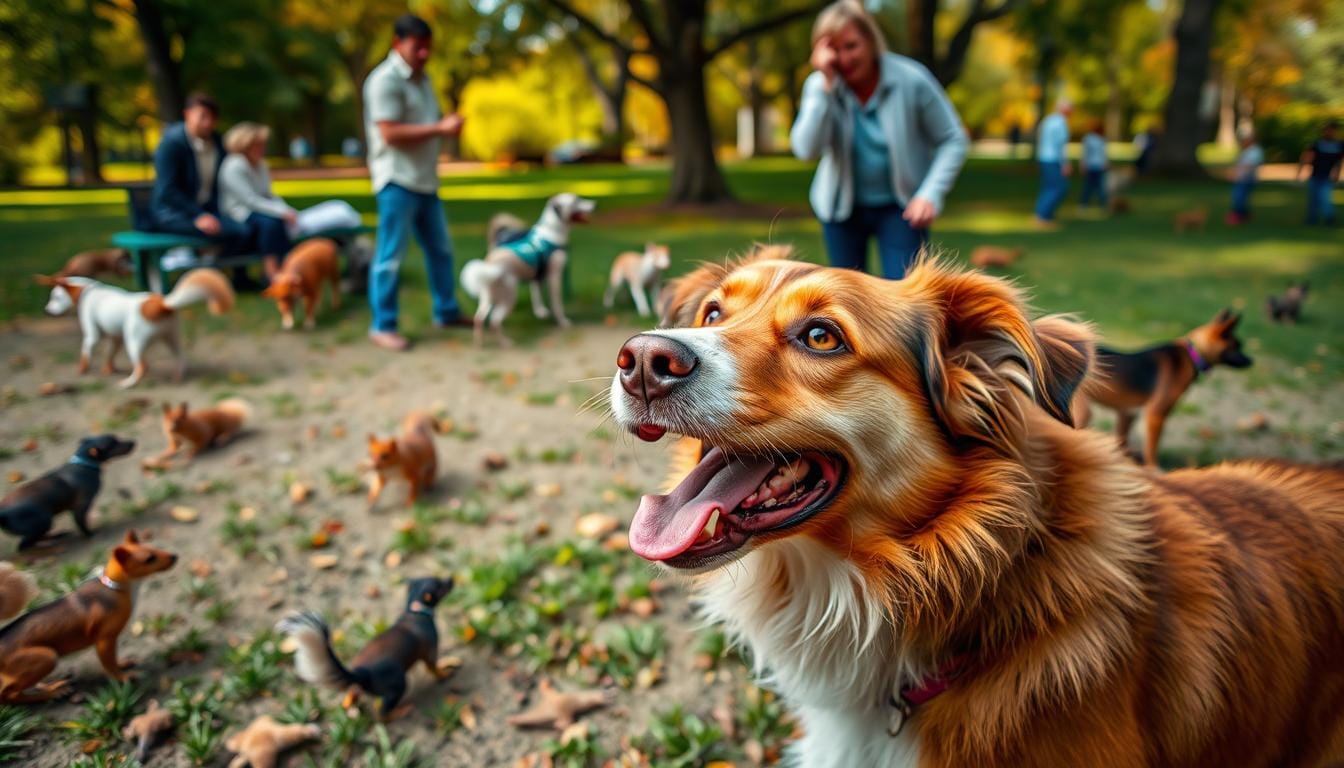
As a dog owner, you’ve probably felt frustrated when your dog ignores you outside. This could happen at the dog park, on walks, or in your backyard. Many things can distract your dog, like leaves, cats, or smells, leading to them not listening 60% of the time1. Knowing why your dog doesn’t listen is key to teaching them better.
Training a disobedient dog needs patience, consistency, and positive rewards. With the right methods, your dog can become a great outdoor friend. Studies show that puppies are more likely to listen when their trainer is energetic and excited1. Also, using high-value treats can boost their focus, with a 75% success rate for trainers who use treats like cooked meats or cheese1.
Key Takeaways
- Environmental stimulation and natural canine instincts can cause a dog to not listen outside.
- Positive reinforcement training techniques are essential for addressing disobedient behavior.
- High-value treats and high-energy training sessions can improve a dog’s attention and engagement.
- Consistency and patience are crucial when training a disobedient dog.
- Understanding the causes of a dog’s behavior is key to developing effective training techniques.
- Building a strong bond with your dog can improve obedience, with 80% of dog owners believing it enhances their dog’s behavior2.
Understanding Why Your Dog Doesn’t Listen Outside
When you take your dog outside, they might not listen as well as they do inside. This could be because of the environment and their natural instincts3. Dogs learn in specific situations and struggle with generalizing, which affects their obedience outside3. To help your dog listen better outside, it’s key to understand these reasons and use consistent training tips.
Improving off-leash behavior involves consistent outdoor exposure and positive training methods4. Using high-value treats can make training faster and more effective4. Also, using a long line can keep your dog safe and focused during training4.
To solve the problem of your dog not listening outside, try these tips:
- Give your dog consistent outdoor time to reduce their reaction to new things3.
- Use positive reinforcement training to encourage good behavior4.
- Train in different places to help your dog apply what they’ve learned3.
The Science Behind Outdoor Distractions
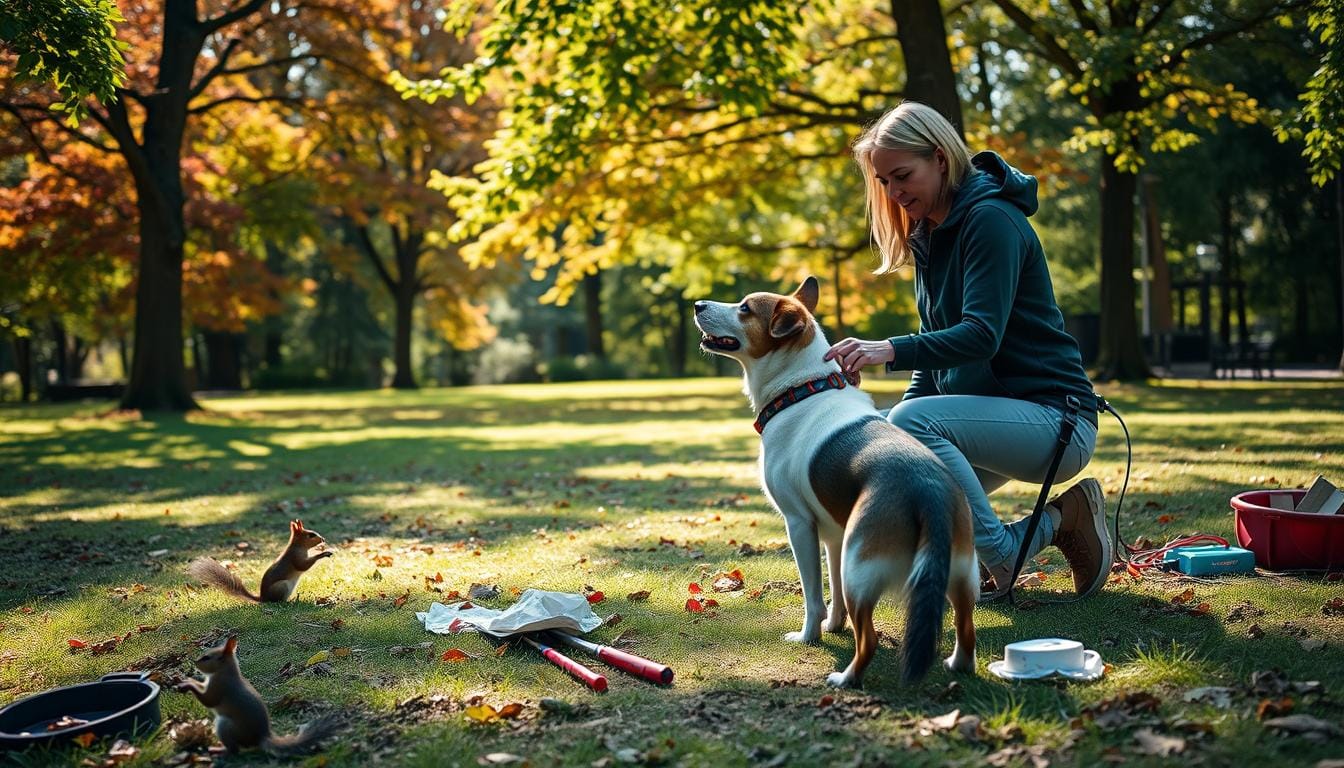
Teaching a dog to listen outdoors is a big challenge. Canine obedience training is key to solving this problem. Many dog owners find their pets listen better in quiet places than in noisy ones5. This is because dogs get distracted by other dogs, people, and sounds.
Understanding why dogs get distracted is important. Studies show that other dogs can make a dog lose focus, affecting up to 70% of them5. Also, giving high-value treats can make a dog more focused, increasing by over 40% compared to regular treats5.
Some good ways to teach a dog to listen outdoors include:
- Gradually increasing distraction levels during training
- Using positive reinforcement methods, such as rewarding desired behavior with treats and praise
- Creating a distraction-free learning environment before introducing distractions gradually
By knowing how distractions work and using the right training, you can make your dog more reliable and focused, even with distractions around6.
| Training Technique | Effectiveness |
|---|---|
| Positive Reinforcement | Up to 70% increase in desired behavior |
| Gradual Distraction Introduction | Up to 60% improvement in focus |
Common Scenarios When Dogs Ignore Commands
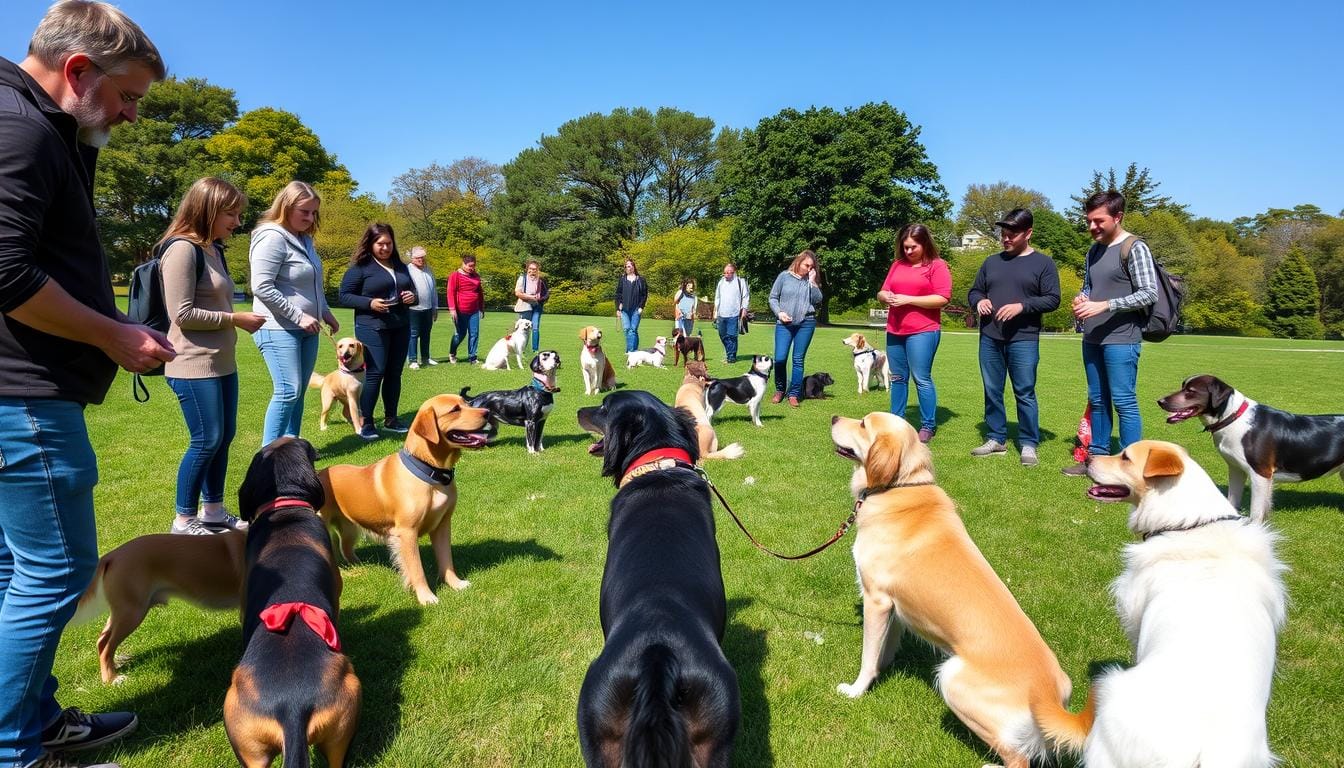
When you take your dog outside, they might ignore your commands. This can be really frustrating. It’s important to manage distractions to help them listen better.
Dogs get distracted by things like other animals, people, and objects. This makes it hard for them to focus on what you’re saying7.
In places like dog parks, neighborhood walks, and open spaces, distractions are even higher. About 40% of dog owners say their dogs don’t listen outside, compared to 15% at home7. To help, train in different places and use treats to reward good behavior.
Some common times dogs ignore commands include:
- At the dog park, where dogs may get overwhelmed by other dogs and stimuli
- During neighborhood walks, where dogs may be distracted by people, cars, and other animals
- In open spaces and fields, where dogs may have too much freedom and get distracted by their surroundings
By understanding these situations and managing distractions, you can improve your dog’s recall. Be patient, consistent, and positive during training. With time and effort, your dog will learn to listen in different places8.
Environmental Factors Affecting Your Dog’s Behavior
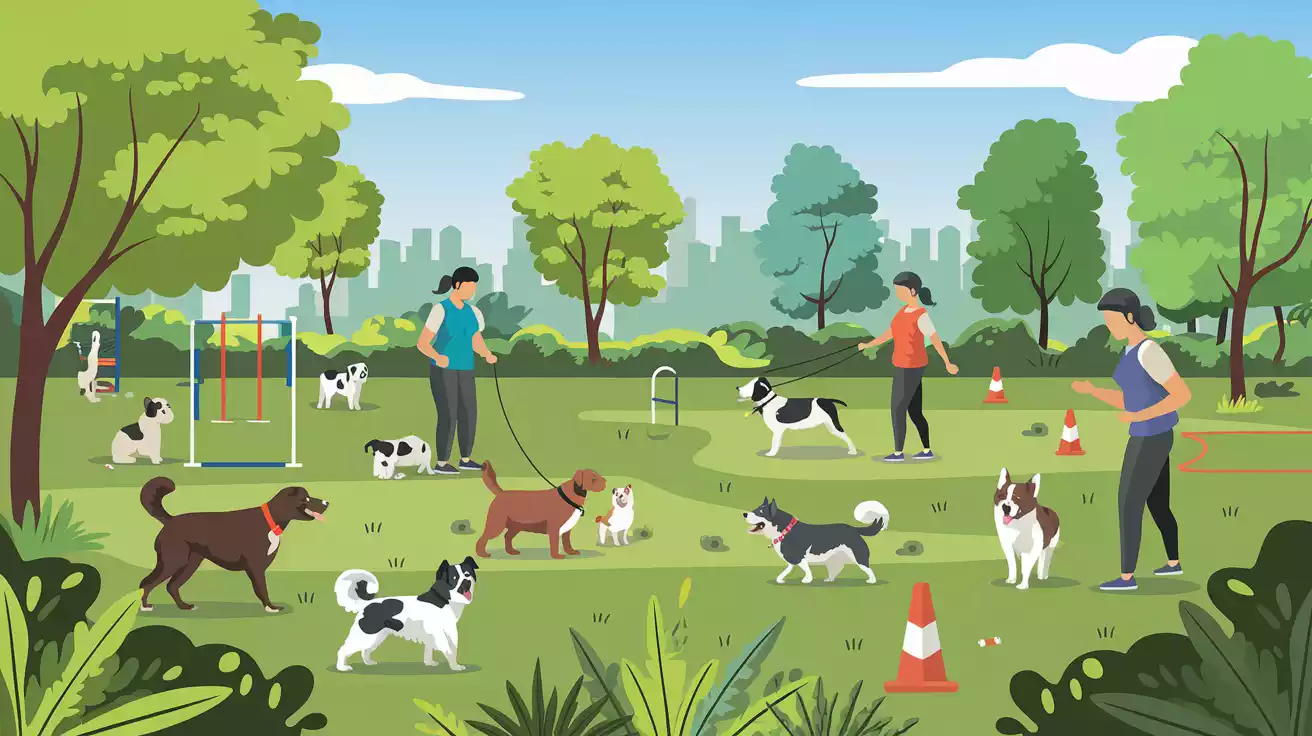
Understanding the environmental factors that affect your dog’s behavior is key. Dogs that are well-socialized before 14 to 16 weeks of age tend to adapt better to new places and situations9. Yet, about 20% of dogs feel anxious or stressed in new places, which can cause behavioral problems9. It’s important to use outdoor dog training tips that help them gradually get used to new environments.
Other dogs or cats can make dogs react on the leash. Studies show that over 60% of dogs misbehave in public because they weren’t socialized enough when they were young9. Also, up to 70% of dog owners notice a big change in their pet’s behavior when they’re in busy places9. Knowing these factors helps you find ways to manage leash reactivity and improve your training outdoors.
Some important outdoor dog training tips include:
- Gradual exposure to new environments to reduce anxiety-related behaviors9
- Positive reinforcement techniques to increase desired behaviors9
- Consistent practice of commands in various situations to prevent miscommunication10
By taking these environmental factors into account and using effective outdoor dog training tips, you can make your dog a well-behaved and responsive friend in any place.
Essential Training Foundations for Outdoor Obedience
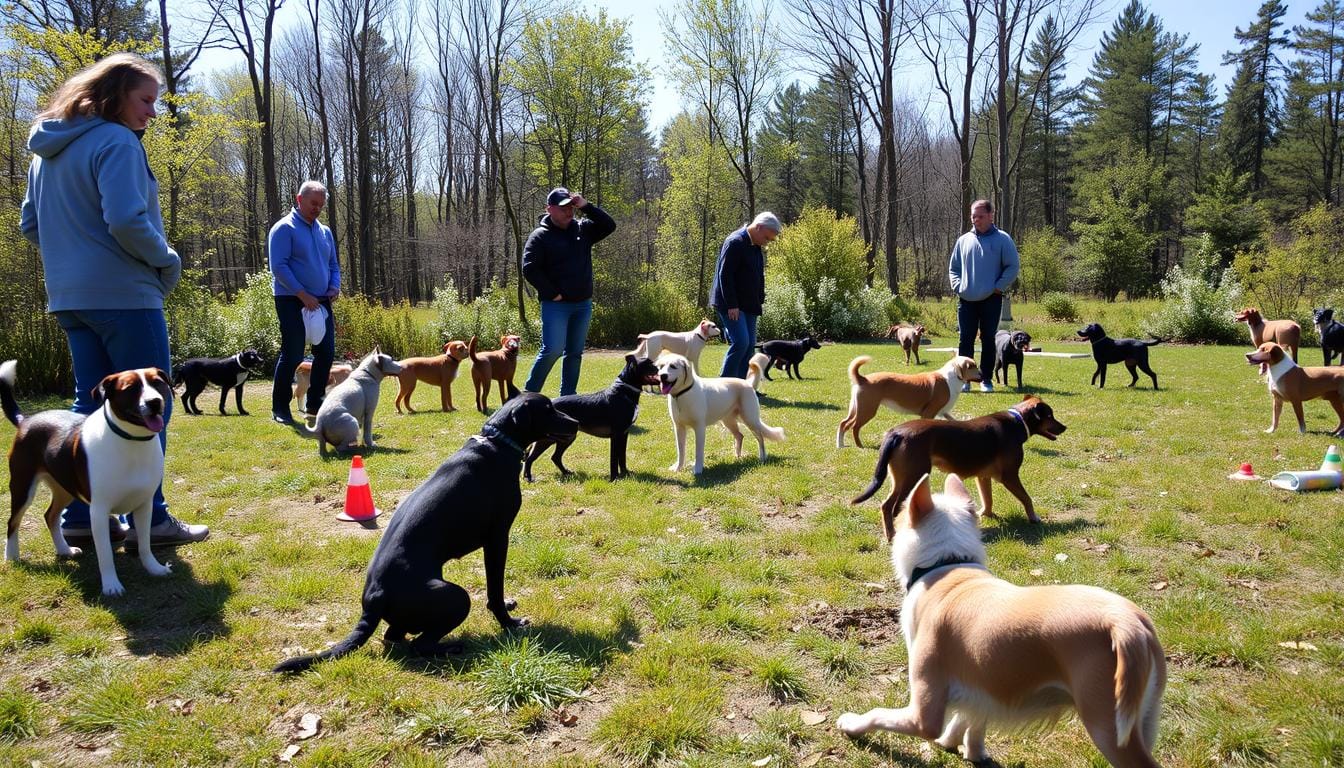
Training a disobedient dog starts with a solid foundation in obedience. This is key to making sure your dog listens to you, even when there are distractions. Many dog owners find it hard to manage their dogs’ behavior outside, where there are lots of distractions11. It’s important to train in quiet places first and then add more distractions.
Teaching your dog to focus is crucial for outdoor training. Dogs find it hard to focus outside because of all the distractions11. Use treats and praise to help them focus on you. The best rewards are those that work well in noisy places12.
Some key techniques for building focus and outdoor obedience include:
- Progressive distance training: Gradually increase the distance between you and your dog while maintaining focus.
- Reward-based conditioning: Use treats, praise, and other rewards to encourage your dog to focus on you.
- Distraction proofing: Expose your dog to various distractions, such as other dogs, people, and noises, while maintaining focus.
By using these techniques and positive reinforcement, you can make your dog well-behaved and obedient. Always be patient and consistent when training a disobedient dog. Use training methods that fit your dog’s needs12.
| Training Technique | Description |
|---|---|
| Progressive Distance Training | Gradually increase the distance between you and your dog while maintaining focus. |
| Reward-Based Conditioning | Use treats, praise, and other rewards to encourage your dog to focus on you. |
| Distraction Proofing | Expose your dog to various distractions, such as other dogs, people, and noises, while maintaining focus. |
Real-Life Case Study: Transforming an Unresponsive Dog
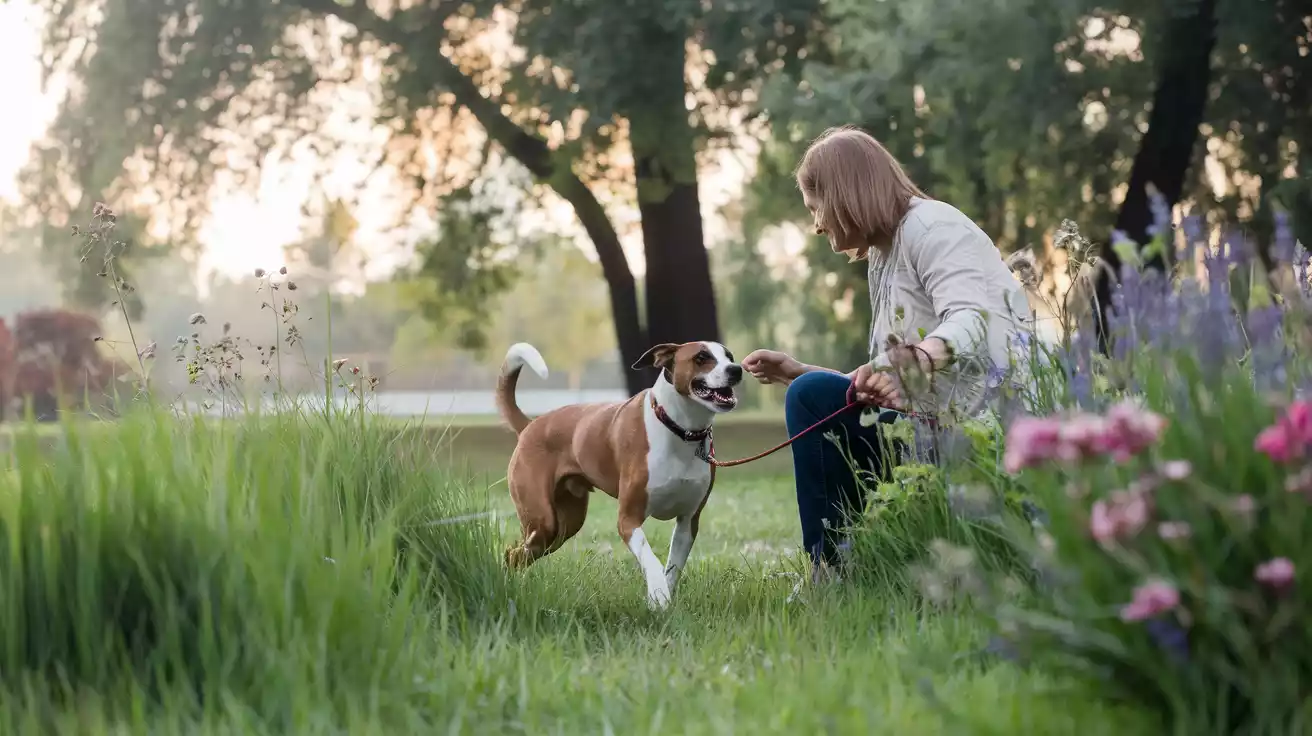
Teaching a dog to listen outdoors can be tough, but it’s doable with the right methods. Dubhy, a Scottish Terrier, was once hard to control. This breed often seems laid-back, making training harder13. But with patience and consistency, Dubhy learned to listen.
Dubhy had been wandering around Chattanooga for weeks. At just 6 months, he was already showing bad habits13. But with a solid training plan, his owners fixed these issues. They taught him to listen even when there were distractions.
Key lessons from Dubhy’s story include the importance of early training and socialization. Puppies are usually full of energy until they’re about 6 to 9 months old14. By using positive methods, you can teach your dog to listen and behave well, even with distractions.
Here are some tips to help your dog listen better:
- Start training early and be consistent
- Use positive reinforcement strategies, such as rewards and praise
- Build focus in low-distraction areas and progressively increase the distance and distractions
- Use corrective devices, such as head halters, to enhance control without discomfort
By following these tips and understanding your dog’s behavior, you can turn an unresponsive dog into a well-behaved pet. They’ll learn to listen and behave well, even off-leash.
| Training Technique | Effectiveness |
|---|---|
| Positive Reinforcement | Highly effective for improving off-leash behavior |
| Corrective Devices | Effective for enhancing control without discomfort |
| Early Training | Essential for preventing unwanted behaviors |
Advanced Techniques for Maintaining Control Outside

As you train your dog, focus on a strong recall command and handling distractions outside. Use advanced methods like emergency recall, distraction proofing, and long-line training15. These techniques help your dog follow commands even when it’s hard.
Dogs struggle to apply what they learn in new places. This can cause them to ignore commands outside15. To fix this, introduce distractions slowly. This helps your dog get used to them. Training this way can make your dog 30% more likely to listen15.
Rewards are key in outdoor training. High-value rewards make dogs more likely to listen when there’s a distraction15. Rewarding good behavior can make your dog nearly 80% more likely to listen in tough situations15. Mix these methods with emergency recall and long-line training for a solid training plan.
- Implementing emergency recall training to ensure your dog responds to commands in critical situations15
- Using distraction proofing exercises to desensitize your dog to distractions15
- Incorporating long-line training methods to improve your dog’s ability to respond to commands in distracting environments15
By using these advanced techniques, you can teach your dog to listen well outside. This makes your dog more reliable and well-behaved16.
Addressing Specific Outdoor Behavioral Challenges
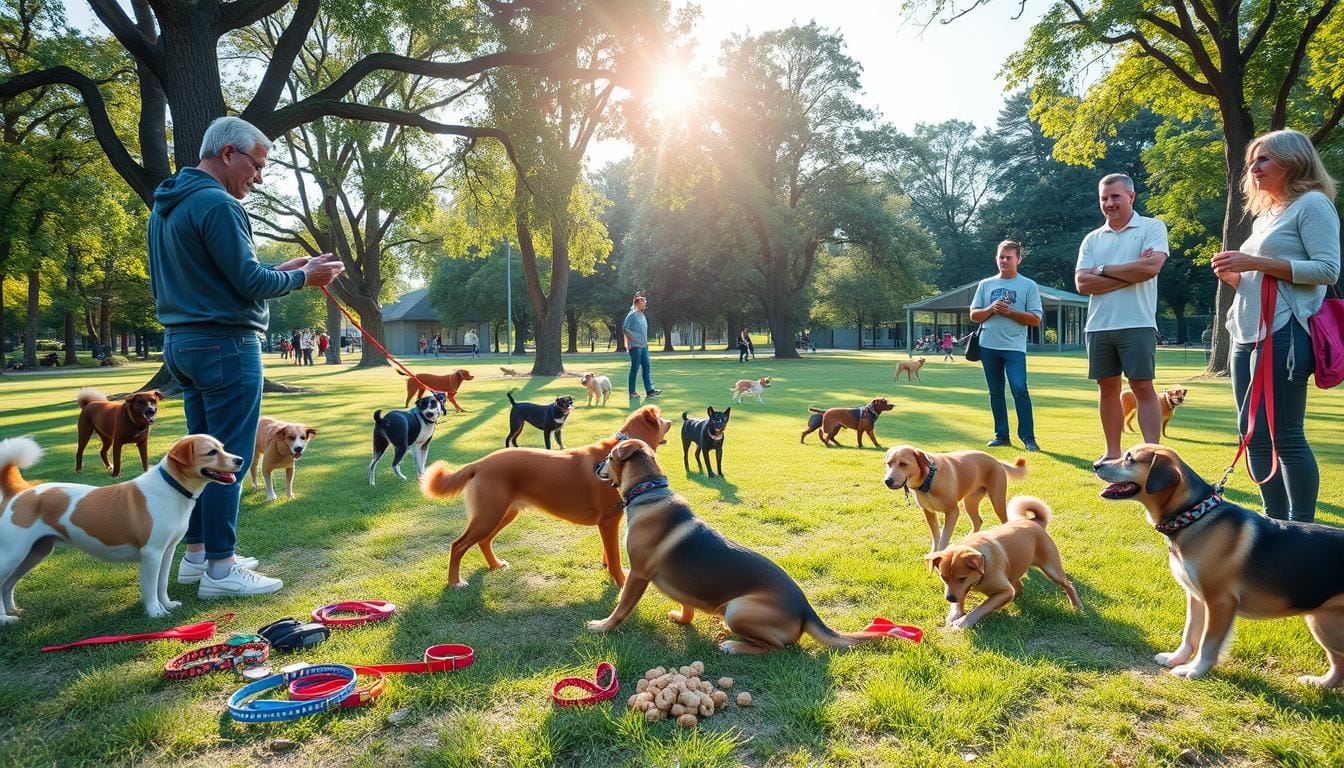
When dealing with unwanted behaviors in dogs, it’s key to understand that most issues stem from poor communication and fear17. To tackle specific outdoor behavioral challenges, like leash reactivity, you must identify the root cause. Leash reactivity can stem from fear, anxiety, or excitement.
Outdoor dog training tips can help manage leash reactivity and other issues. For instance, training in quiet spots helps focus on your dog17. Positive reinforcement, like rewards for good behavior, helps your dog learn to associate positive outcomes with good actions.
Some behaviors, like ignoring cues or pulling on the leash, might seem stubborn17. But, they can often be fixed with the right training and communication. Understanding why your dog behaves a certain way and using effective training can make them a well-behaved and loyal friend.
Environmental factors, like weather, also play a role in your dog’s behavior17. By considering these factors and adjusting your training, you can help your dog overcome outdoor challenges. This makes them more confident and well-behaved.
By following these tips and understanding the causes of specific behaviors, you can help your dog become a well-behaved and loyal friend. Always use positive reinforcement and tailor your training to your dog’s needs and situation18.
Get Your Dog to Listen Outside with Proven Training Techniques
Is your dog ignoring commands outdoors, leaving you frustrated? You’re not alone—but there’s a simple solution!
With Adrienne Farricelli’s Brain Training for Dogs, unlock your dog’s intelligence to overcome distractions and create the obedient, focused companion you’ve always wanted.
Why Choose This Program?
✅ Solve outdoor behavior issues.
✅ Strengthen your bond with fun, science-backed methods.
✅ Access expert guidance and videos anytime.
Act Now!
Start seeing results today with this risk-free program, backed by a 60-day guarantee.
👉 Click Here to Get Started with Brain Training for Dogs!
Don’t wait—give your dog the training they deserve outdoors!
Conclusion: Creating a Reliable Outdoor Companion
Helping your dog become a well-behaved outdoor companion takes patience and consistency. You need to understand their unique needs. By fixing the reasons they don’t listen, like distractions and lack of training, you can make them a trusted partner for outdoor adventures19.
Use methods like progressive distance training and reward-based conditioning. These help your dog focus and obey, even in busy places19. Always train with a positive and patient attitude. This way, your dog will grow strong in your bond and trust19.
Spending time and effort on training makes your dog a reliable outdoor friend. You’ll feel more at ease and your bond will grow stronger. With the right tools and strategies, your dog can overcome distractions and be a well-behaved partner for exploring the world1920.
FAQ
Why doesn’t my dog listen to me when we’re outside?
Dogs may not listen as well outside for several reasons. Environmental stimulation and natural instincts play a big role. Also, not enough training can make it hard for them to focus.
How can I improve my dog’s off-leash behavior?
To better your dog’s off-leash behavior, start with basic obedience training. Use low-distraction areas to build focus. Then, move to progressive distance training and reward-based methods.
What techniques can I use to teach my dog to listen outdoors?
To teach your dog to listen outside, manage distractions during training. Build a strong recall command. Practice exercises that help your dog ignore distractions.
How do I handle my dog’s leash reactivity outside?
To handle leash reactivity, try training in low-distraction areas. Use long-line training to help your dog learn to walk calmly. Addressing the reasons behind their reactivity is key.
What are the essential training foundations for outdoor obedience?
The key to outdoor obedience is building focus and using reward-based training. Start in quiet areas and gradually increase distance. These techniques will help your dog listen better outside.
Source Links
- https://www.petprofessionalguild.com/pet-owners/pets-and-their-people/pets-and-their-people-blog/puppy-not-listening-to-you-heres-why-and-what-to-do/ – Puppy Not Listening to You? Here’s Why and What to Do! – Pet Professional Guild
- https://theonlinedogtrainer.com/how-to-improve-dog-obedience/ – Stop Disciplining and Start Connecting: How to Improve Dog Obedience
- https://awokenk9.com/dog-wont-listen-outside/ – Number 1 Reason Why Your Dog Won’t Listen Outside| Awoken K9
- https://zigzag.dog/en-us/blog/puppy-training/training-basics/how-to-get-your-dog-to-focus-on-you-outside/ – How To Get Your Dog To Focus On You Outside – Zigzag
- https://smartdoguniversity.com/what-to-do-if-your-dog-doesnt-listen-in-public/ – What to Do If Your Dog Doesn’t Listen in Public – Smart Dog University
- https://smartdoguniversity.com/category/teach/page/9/ – Teach Archives – Page 9 of 16 – Smart Dog University
- https://www.3lostdogs.com/3-reasons-your-dog-ignores-your-commands-outside/ – 3 Reasons Your Dog Ignores Your Commands Outside
- https://www.caninecampus.us/6-reasons-your-dog-ignores-your-commands-outside – 6 Reasons Your Dog Ignores Your Commands Outside – Canine Campus Dog Daycare & Boarding
- https://neaterpets.com/blogs/news/dog-doesnt-behave-in-public – Why Doesn’t My Dog Behave in Public?
- https://thedogspov.com/what-can-impact-on-your-dogs-behaviour/ – Dogs are Not Robots: Things That Can Affect Your Dogs Behaviour
- https://thelightofdog.com/help-my-dog-doesnt-listen-when-were-outside/ – Help, my dog doesn’t listen when we’re outside! – The Light Of Dog
- https://www.akc.org/expert-advice/training/training-dogs-to-ignore-distractions/ – No title found
- https://www.whole-dog-journal.com/behavior/causes-of-reactive-dog-behavior-and-how-to-train-accordingly/ – How To Train a Reactive Dog | Reactive Dog Causes
- https://vcahospitals.com/know-your-pet/disobedient-unruly-and-excitable-dogs – Disobedient, Unruly and Excitable Dogs | VCA Animal Hospitals
- https://dogsnet.com/getting-a-dog-to-listen-outdoors/ – Getting Your Dog To Listen Outdoors – dogsnet.com
- https://www.akcpetinsurance.com/blog/train-your-dog-to-behave-in-public – How to Train Your Dog to Behave in Public | AKC Pet Insurance
- https://www.dognerdly.com/training/how-to-train-a-stubborn-dog/ – How to Train a ‘Stubborn’ Dog
- https://www.doggoneproblems.com/bowie-dog-afraid-to-go-outside/ – How to Help a Dog Afraid to Go Outside
- https://www.upstatecanine.com/blog/possible-reasons-your-dog-wont-listen-to-basic-commands/ – Possible Reasons Your Dog Won’t Listen to Basic Commands – Upstate Canine Academy
- https://www.outsideonline.com/culture/raising-perfect-dog/ – Raising the Perfect Dog



